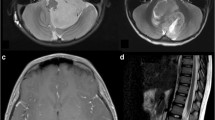Abstract
Purpose
To improve uniformity in radiological review/reporting and discussion of surgical resection status in the forthcoming SIOP Ependymoma II trial, a central review of imaging and resection status will be carried out prior to treatment stratification. We present a review of surgical decision-making from the UKCCSG/SIOP Ependymoma trial for very young children (<3 years) (Lancet Oncol 8:696–705, 2007) and propose a primary surgical staging system for residual disease that could be used for Ependymoma II.
Methods
Imaging of 89 patients enrolled in the UKCCSG infant Ependymoma trial was independently reviewed by 3 experienced paediatric neuro-oncology surgeons. Pre- and post-op MRI imaging was available for 28 posterior fossa cases with incomplete resection. Location of residual disease, decision to offer ‘second-look’ surgery (prior to adjuvant therapy), perceived chance of complete resection, and risk to cranial nerves was assessed. Recommendation for second-look surgery was compared with actual second-look surgery.
Results
In the actual study period, 13 patients (46 %) had further surgery at some point. The independent panel, after blinded review of the imaging, would have offered 19 patients overall (68 %) in this same cohort up-front early second-look surgery prior to definitive adjuvant therapy. We devised a 5-point staging system to introduce consistency in staging residual disease and resectability, and this is presented.
Conclusions
Based on scans alone, a surgical panel would have offered second-look surgery to 68 % of patients with residual ependymoma. The potential benefits and drawbacks of a surgical review panel and classification system will be discussed in the context of the forthcoming Ependymoma II trial.



Similar content being viewed by others
References
Muellar S, Chang S (2009) Pediatric brain tumours: current treatment strategies and future therapeutic approaches. Neurotherapeutics 6(3):570–586
Ross GW, Rubinstein LJ (1989) Lack of histopathological correlation of malignant ependymomas with postoperative survival. J Neurosurg 1(70):31–36
Timmermann B, Kortmann RD, Kühl J, Meisner C, Slavc I, Pietsch T, Bamberg M (2000) Combined postoperative irradiation and chemotherapy for anaplastic ependymomas in childhood: results of the German prospective trials HIT 88/89 and HIT 91. Int J Radiat Oncol Biol Phys 46(2):287–295
Robertson PL, Zeltzer PM, Boyett JM, et al. (1998) Survival and prognostic factors following radiation therapy and chemotherapy for ependymomas in children: a report of the Children’s Cancer Group. J Neurosurg 88(4):695–703
Grundy RG, Wilne SA, Weston CL, et al. (2007) Primary postoperative chemotherapy without radiotherapy for intracranial ependymoma in children: the UKCCSG/SIOP prospective study. Lancet oncol 8(8):696–705
Merchant TE, Chenghong L, Xiong X, Kun LE, Boop FA, Sanford RA (2009) A prospective study of conformal radiation therapy for pediatric ependymoma. Lancet Oncol 10(3):258–266
Morris EB, Chenghong L, Khan RB, Sanford RA, Boop F, Pinlac R, Xiong X, Merchant TE (2009) Evolution of neurological impairment in pediatric infratentorial ependymoma patients. J Neuro-Oncol 94(3):391–398
Ramaswamy V, Hielscher T, Mack SC (2016) Therapeutic impact of cytoreductive surgery and irradiation in the molecular era: a retrospective multicohort analysis. J Clin Oncol 34(21):2468–2477
Author information
Authors and Affiliations
Corresponding author
Ethics declarations
Conflict of interest
The authors report no conflict of interest concerning the materials or methods used in this study or the findings specified in this paper.
Rights and permissions
About this article
Cite this article
Millward, C.P., Mallucci, C., Jaspan, T. et al. Assessing ‘second-look’ tumour resectability in childhood posterior fossa ependymoma—a centralised review panel and staging tool for future studies. Childs Nerv Syst 32, 2189–2196 (2016). https://doi.org/10.1007/s00381-016-3225-9
Received:
Accepted:
Published:
Issue Date:
DOI: https://doi.org/10.1007/s00381-016-3225-9




